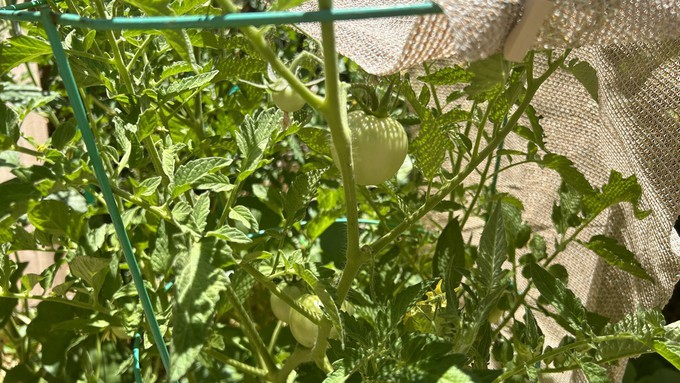
Tips to help keep gardeners, gardens more comfortable in triple-digit weather

A shade cloth (or burlap or a lace tablecloth) hung on a tomato cage can protect developing fruit from sunburn during a heat emergency. Kathy Morrison
Are you ready for 109 degrees?
That’s the forecasted high for Sacramento on Saturday, says the National Weather Service. And that won’t be the only super-hot day. The Sacramento region will be under “Excessive Heat Watch” from 11 a.m. Friday through 8 p.m. Monday.
“Widespread MAJOR Heat Risk will impact our area this weekend,” tweeted the NWS Sacramento office on Tuesday. “This heat will be dangerous to anyone without proper hydration and cooling. Reconsider outdoor plans and if you must go outside, take frequent breaks in the shade and drink plenty of water.”
According to the NWS, the Sacramento region can expect “dangerously hot conditions with daytime high temperatures 98 to 113 with overnight lows in the upper 60s to low 80s possible.”
The heat watch includes a wide area: “Sacramento Valley, Northern San Joaquin Valley, Motherlode, Northeast Foothills, Burney Basin, Coastal Range, Delta, Shasta County Mountains, and portions of the West Slope Northern Sierra Nevada and Lassen/Western Plumas Counties for elevations below 4,500 feet.”
So even retreating up into the Sierra won’t bring much relief.
While people (and pets) can retreat indoors, our plants aren’t so lucky. Before Friday, make a point to deep water perennials, shrubs and trees.
Move potted plants into partial shade if possible. Containerized gardens may need daily watering during this heat wave.
Don’t let tomatoes, squash, peppers and other developing fruit dry out completely; that can lead to blossom end rot and other problems.
Here are more hot weather survival tips for gardeners and gardens:
* Stay hydrated! That applies to both you and your garden. Water early in the day – before 8 a.m. if possible – to cut down on evaporation.
* Cycle and soak. Water needs a chance to soak in, especially if you have clay soil. Otherwise, it will run off (and down the drain) instead of reaching roots. Run your irrigation for a short period. Wait an hour or two. Then, run your system again. The water from the second cycle will reach deeper than the first.
* Mulch, mulch, mulch! A layer of 3 inches of straw, wood chips, dried leaves or other organic material will keep soil and roots cooler while conserving moisture.
* Shade any sensitive plants and developing fruit on tomatoes, peppers, eggplant and squash. Your harvest can get sunburned. Protect from intense afternoon rays with temporary shade such as burlap draped over trellises.
* Wilting can be normal. Some big-leafed plants such as squash may seem to wilt every hot afternoon; that’s OK. They recover overnight. It’s when they’re still wilted in the morning that it’s a problem.
* Check the soil before you water. It may look dry on top, but still have enough moisture in the root zone 6 inches below the surface. Plants can suffer from too much water (especially in containers) as well as not enough.
Heat is often on the minds behind Sacramento Digs Gardening. Here are links to several past columns with heat-related advice:
-- Get Ready for Hot Days Ahead
-- Mulch is Good, and More Mulch is Better
-- 5 Hacks for Shading Your Precious Vegetables
-- Hot Tomato! How to Help Your Vines During High Heat
-- Speaking for the Trees: Don't Forget Them in This Heat
-- For Best Roses in Heat, Watch Water and Mites
And if you’re too late:
-- Rescuing a Heat-Stressed Plant
Finally, for the gardener:
--- Too Hot to Think? Follow These Tips
– Debbie Arrington and Kathy Morrison
Comments
0 comments have been posted.Sacramento Digs Gardening to your inbox.
Sites We Like
Garden Checklist for week of July 21
Your garden needs you!
* Keep your vegetable garden watered, mulched and weeded. Water before 8 a.m. to reduce the chance of fungal infection and to conserve moisture.
* Feed vegetable plants bone meal, rock phosphate or other fertilizers high in phosphate to stimulate more blooms and fruiting. (But wait until daily high temperatures drop out of the 100s.)
* Don’t let tomatoes wilt or dry out completely. Give tomatoes a deep watering two to three times a week.
* Harvest vegetables promptly to encourage plants to produce more. Squash especially tends to grow rapidly in hot weather. Keep an eye on zucchini.
* Pinch back chrysanthemums for bushy plants and more flowers in September.
* Remove spent flowers from roses, daylilies and other bloomers as they finish flowering.
* Pinch off blooms from basil so the plant will grow more leaves.
* Cut back lavender after flowering to promote a second bloom.
* It's not too late to add a splash of color. Plant petunias, snapdragons, zinnias and marigolds.
* From seed, plant corn, pumpkins, radishes, winter squash and sunflowers.